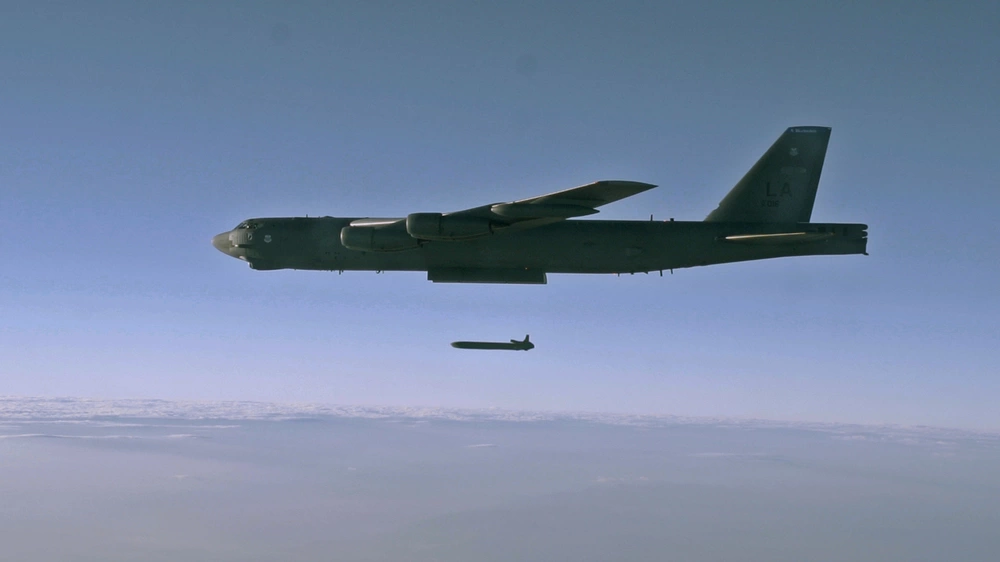Rebuttal: Current nuclear weapons policy not safe or sane
By Stewart Prager, Alan Kaptanoglu | May 24, 2022
 An unarmed AGM-86B Air-Launched Cruise Missile is released from a B-52H Stratofortress over the Utah Test and Training Range during a Nuclear Weapons System Evaluation Program sortie Sept. 22, 2014 (U.S. Air Force photo by Staff Sgt. R. Carlson)
An unarmed AGM-86B Air-Launched Cruise Missile is released from a B-52H Stratofortress over the Utah Test and Training Range during a Nuclear Weapons System Evaluation Program sortie Sept. 22, 2014 (U.S. Air Force photo by Staff Sgt. R. Carlson)
It is hard to overstate the importance of nuclear weapons policies, for any nuclear use would have catastrophic consequences. Discussion of these policies, however, is often hampered as they are held within silos. In a February 2022 article in the Bulletin of the Atomic Scientists, we critiqued one example of messaging within one such silo, the US defense establishment. We focused our critique on the book, Guide to Nuclear Deterrence in the Age of Great-Power Competition, published by the Louisiana Tech Research Institute. Our article prompted a robust response in the Bulletin by Adam Lowther, a political scientist at the Army Management Staff College at Ft. Leavenworth and editor of this guide. We are pleased our article prompted a discussion between those who promote arms control or disarmament—and those who do not.
Lowther’s objections to our article illustrate fundamental differences in the perspectives of the two camps, and they offer an uncommon opportunity to engage across silos. In this spirit, we discuss below some of the underlying differences in assumptions or conclusions between Lowther’s and ours. We begin with a fundamental issue that he raises: Who is qualified to participate in the debate over US nuclear weapons policy?
Who qualifies for the debate. What knowledge, experience, or expertise is needed to contribute usefully to this discussion? Lowther’s view is explicit: Whereas we (the authors of this article) “act as arm-chair generals,” he reminds that “the contributors to the guide were actual generals, admirals, colonels, presidential appointees, and civil servants actively engaged in planning and decision-making during and after the Cold War.” While those engaged with the US nuclear weapons apparatus are privy to important technical knowledge about their operation, discussion about nuclear policy issues should be open to all. In the United States, as in any functioning democracy, military policy and strategy should remain within the purview of the public. The “arm-chair generals” label is not apt because it goes against this fundamental principle of US democracy.
Moreover, when it comes to nuclear war, we are all arm-chair generals, equally lacking in experience. No one has ever fought a nuclear war. No one can fully grasp or predict the geopolitical consequences of nuclear use. No one can determine the exact material and human consequences that would follow the use of nuclear weapons—even from well-understood causes like blast, fire, and radioactive fallout. We are all especially ignorant of the massive deaths that could accrue from the societal collapse caused by the destruction of critical infrastructure, electric grid, and health care system, or via the mass starvation brought on by the sun-blocking effects of soot rising from burning cities. No one knows the consequences even of a limited nuclear war. All prior wars have used weapons that were less than one-10,000th the power of the nuclear weapons available today; such experience provides little guidance for nuclear exchanges. All it provides is a warning that in war there is uncertainty, which can lead to global catastrophe if nuclear weapons are available for use.
In the realm of international politics, no political actors can know all the possible pathways of escalation from conventional to nuclear war. The war in Ukraine is illustrative: there are multiple pathways for inadvertent escalation between Russia and NATO members, but their plausibility is anyone’s guess. It is unknown where the point of no return resides. For instance, many worry that Putin might see US sanctions and assistance to Ukraine as a form of escalation worthy of nuclear retaliation. But no one knows how he will respond. In the arena of nuclear weapons, there are no adults in the room. Observing the ineffectiveness of planning for nuclear war, former head of Strategic Air Command Gen. Lee Butler noted that deterrence “was premised on a litany of unwarranted assumptions, unprovable assertions and logical contradictions” and that “the capacity for human and mechanical failure, and for human misunderstandings, was limitless.”
Yet Lowther believes that to have an informed opinion on this topic, one must be an expert in nuclear deterrence theory. But deterrence theory is not rocket science. Except for aspects of mathematical logic or game theory applied to deterrence, this “theory” is essentially a collection of suspect assumptions and speculations on how one state would respond to the actions of an adversary. We can all partake in those speculations.
This is not just a philosophical point; it has two practical consequences. First, overconfidence and a belief in special knowledge can lead those with control over nuclear weapons to grave error. Second, the “deterrence theory experts only” attitude promotes the appearance of a US nuclear priesthood with special insight and expertise. Combined with nuclear weapons being out of sight for all but a few within the public, this has likely contributed to the weakening of US public democratic participation in determining nuclear weapons policies.
Can a nuclear war be won? Lowther argues that the Gorbachev-Reagan dictum “a nuclear war cannot be won” was true for their time, but not for ours. He points out that previously “the Soviet Union fielded more than 40,000 nuclear weapons, many of which had megaton yields. The United States fielded approximately 24,000 nuclear weapons which also often carried megaton warheads.” At that time, nuclear war clearly threatened the end of civilization. But Lowther then recalls that since then the two nuclear arsenals have decreased by about 90 percent. He then states that currently “the assertion that a nuclear detonation will end civilization and turn the world into a nuclear wasteland is simply not true.” One nuclear detonation would certainly not be the end to civilization. But what about a nuclear war?
Lowther’s statement is a disturbingly and dramatically incorrect assessment of the physical power of nuclear weapons today. There are over 9,000 nuclear warheads in the world’s military stockpile (mainly in Russia and the US). Most are roughly 10 to 20 times more powerful than the bomb that annihilated the city of Hiroshima and over 100,000 people within it. The remaining math is then simple. Only considering the direct effects of nuclear weapons (blast, skin burns and radiation) the current arsenal could kill billions of people. The indirect effects, including societal collapse and mass starvation, could kill many more and end civilization as we know it.
As supposed evidence for his assessment, Lowther notes that the world experienced over 2,000 nuclear weapon tests and yet civilization is still here. Lowther speaks from his own experience, essentially as a tourist: “I have walked the test sites ….and toured Hiroshima and Nagasaki. The assertion that a nuclear detonation will end civilization and turn the world into a nuclear wasteland is simply not true. I have seen it with my own eyes.” This is not a serious argument. Nuclear tests have been conducted where there are no population centers: underground, above the ocean, in the desert (although wind-blown nuclear fallout from some of these tests did cause many harms). If one fires a bullet into the ocean, it does not prove that guns cannot kill people. It is unfortunate Lowther could not tour Hiroshima in 1945, before the city was rebuilt.
However, we take seriously this critique that large-scale nuclear detonation may not truly end civilization. It might seem plausible indeed to detonate thousands of nuclear weapons during a war without killing millions, by targeting only the subset of strategically significant sites where there are not many people. This is the aspiration of the US counterforce strategy. However, there is no basis to think that during a brutal war that all—or any—of the participants will limit themselves to isolated targets. Therefore, the idea of a “humane” counterforce strategy appears almost always illusory. Moreover, many military targets or strategic assets reside in or near major cities or lesser population centers, and fallout and other effects can extend geographically. US Defense Department employee Gil Klinger discovered that the US counterforce plans in 1989 had an incredible 689 nuclear weapons aimed at targets located within 50 miles of Moscow. Counterforce also promotes fear of a debilitating first strike, potentially heightening nuclear tensions and incentivizing larger nuclear arsenals. This is one reason why many arms control organizations are strongly lobbying for the US adoption of an explicit “no-first-use” nuclear policy.
Because Lowther underestimates the lethality of the current nuclear arsenals, he can confidently conclude that “the United States [has] no choice but to plan to fight and win a nuclear war,” if Russia were to use low-yield nuclear warheads in a conflict. But Lowther does not explain what would constitute such a hypothetical “win” for the US in a nuclear war with Russia, a war that could well lead to the utter destruction of the United States and Russia.
Rather than there being “no choice” but to fight a nuclear war if Russia were to use low-yield nuclear weapons, high-ranking US officials have previously suggested the opposite. For example, in a war game held by the US National Security Council in 2016, it was proposed that if Russia used a tactical nuclear weapon to “escalate to de-escalate,” the best option for the United States would be to respond with conventional forces, sanctions, and rallying the global community, with the enormous upside of not risking an all-out nuclear war. And more recently, Gen. John Hyten reported a similar conclusion from wargames, stating that “It ends bad. And the bad meaning it ends with nuclear war.” Fortunately, the commander of US Strategic Command, Adm. Charles Richard, did not share Lowther’s view when he recently reaffirmed that a nuclear war cannot be won.
Lowther notes that US policy holds nuclear warfighting as a last resort, to be enacted only after all other means of de-escalation have failed, and that “no member of the United States military desires war, especially nuclear war.” This is all true. Surely, no sane member of the public or the military would ever desire nuclear war. The irony—and the problem—is that all of us sane people live within an insane system in which a strategic last resort is potentially genocide and suicide.
The implications of close calls. There have been many well-known close calls with nuclear weapons—technical or human errors that nearly led to inadvertent launch. The most infamous example might be the variety of incidents of false warning when catastrophe was averted by someone in the military chain of command intuiting that the warning was likely false. Fortunately, none of these close calls led to nuclear conflict. We attribute survival to these near nuclear uses partly to luck, as have many scholars and defense leaders. In many cases, were it not for the intuition of someone in the chain of command—often disobeying protocol—the result could have been nuclear war.
But Lowther draws a different conclusion. For him, it is not luck but the “safety systems [that] worked 100 percent of the time” that, he asserts, indisputably prevented nuclear use. This statement is false. In many cases, the safety systems failed partially—or even entirely—as any safety engineer, or anyone who has worked with complex technological systems, will know. Any of the documented false warning incidents is a safety system failure. Several times, the failure of sensors was sufficiently acute as to generate the impression of impending attack. Retaliation was avoided by someone in the chain of command intuiting the error and acting outside of training protocols. Avoidance of accident through extraordinary performance beyond that expected or within training, constitutes a failure of the safety system. Nuclear close calls—perhaps inevitable in a complex system—are extremely alarming.
Lowther then concludes: “Given the modern safety systems in our weapons, the chances of an accidental detonation are even lower today.” He provides no basis for this speculation. There are both gains and losses in safety. Does his comment apply to India, Pakistan, China and the other nuclear weapon states? Does his assessment include the new threats from cybersecurity, the new complexities coming from missile defense, and the vulnerabilities introduced by modern information technology? The risk of accident could well be greater today with modern technology, more nuclear weapon states, and additional geopolitical situations introducing potential sources of error.
Nuclear weapons as peacekeepers. Despite acknowledging that several political, social and economic factors can inhibit war between two nuclear weapon states, Lowther waves these away and declares: “Nuclear weapons are still the primary reason that nuclear armed states do not go to war.” Again, this is a conjecture. Lowther ignores here the literature on historic trends and statistical studies that argue the opposite. His evidence? His own interpretation of the past weeks of the Ukraine crisis.
Even if it were true nuclear weapons could help avoid war in many cases, it is far too risky to rely upon that tool. It would not be good enough if nuclear weapons can avert war in say 90 percent—or even 99 percent—of tense moments. Given the unthinkable potential lethality of nuclear weapons, they would have to work as a deterrent nearly perfectly—that is, more than 99.9 percent of the time. If one cannot guarantee with certainty that nuclear weapons will never be used—and one cannot—then nuclear weapons introduce far too great a danger to be possessed.
The launch-on-warning option. The United States and other nuclear states maintain an option of launching nuclear weapons upon a warning of an attack by an adversary before the attacking missiles have hit their targets. In such a situation, the US president would have some five to 10 minutes to deliberate and reach a decision on whether to retaliate while the attacking missiles are in flight. In the United States, this option is backed by the posture of nuclear weapons, such as maintaining all 400 silo-based ICBMs and half of the sea-launched ballistic missiles on alert status, always ready for immediate launch. We subscribe to the view that maintaining the launch-on-warning option is dangerous, prone to mistakes, and unnecessary.
On this issue, Lowther vigorously states: “the United States does not maintain a policy of launch on warning with the intercontinental ballistic missile force. To insist otherwise is a lie. The argument is false and belies an ignorance of strategy, policy, doctrine, and tactics, techniques, and procedures.”
This statement is difficult to parse. Perhaps Lowther is focusing on the use of terms and drawing a distinction between a launch-on-warning policy—a term we did not use—and a launch-on-warning option available to the president. It is correct that the US does not have a policy to launch on all warnings. But it is also correct to observe that the US implicitly supports the option of launch on warning, backed by a nuclear posture in which hundreds of nuclear-tipped missiles are on alert. This posture was adopted in the 1970s and continues to this day, which one could argue makes it a de facto policy.
The linked reference cited by Lowther to back up his strenuous statement is also questionable. It merely points out that there has likely never been an instance when the president was put in the position of having to make such a launch-on-warning decision. It is fallacious to assume that something cannot happen because it has not yet occurred.
We do not understand the otherwise unexplained objection of Lowther to the existence of this option in US nuclear strategy—an option Gen. Butler stated would be urged upon the president. If this is incorrect, we would very much welcome evidence to the contrary.
Lessons from Ukraine. For Lowther, the lesson of the war in Ukraine is simple: “If the US and Russia manage to avoid a nuclear conflict … it will be the fear of nuclear war that drives both nations to deescalate.” This argument does not make logical sense. Lowther argues that nuclear weapons are useful because they prevent nuclear war. But, if the United States and Russia did not possess nuclear weapons, a nuclear war would then be impossible anyway.
Perhaps Lowther is trying to say that without nuclear weapons, the current conflict could escalate to a major conventional war between the two nuclear powers. That is a possibility. Of course, it is also possible that without the cover—and threat of use—of nuclear weapons, Putin would not have invaded Ukraine. However, no one can draw definitive conclusions from these what-if scenarios.
We draw a different observation from the crisis though, one that is not speculative. During this war, the world has been held hostage to the psychology of one man, Vladimir Putin, who shows little reluctance to commit atrocities. Through his command of thousands of nuclear warheads, he also has the capacity to murder hundreds of millions of people and destroy Europe or even the United States on short notice. Under no scenario is this a safe, sane or supportable situation. This is not an isolated bug of the nuclear world order. It is a systemic feature that will repeat again and again as long as these weapons continue to exist. Nuclear standoff prolonged indefinitely into the future is a catastrophe waiting to happen.
To close, let us return to the point that prompted this discussion in the first place: the messaging from the US defense leadership to its workforce. Lowther’s article highlights and validates our initial criticism. The information on nuclear deterrence presented to the military often contains certainty where none is possible, a false sense of expertise that is not attainable, an understatement of the existential lethality of nuclear weapons, and a complacency regarding risks of accidents or escalation. Those who devote their professional lives to the US military need and deserve better. “Preaching to the choir” is common in nuclear deterrence discussions, and insufficient crosstalk occurs. For this, it is important that we keep the discussion open—and open across all silos.
Together, we make the world safer.
The Bulletin elevates expert voices above the noise. But as an independent nonprofit organization, our operations depend on the support of readers like you. Help us continue to deliver quality journalism that holds leaders accountable. Your support of our work at any level is important. In return, we promise our coverage will be understandable, influential, vigilant, solution-oriented, and fair-minded. Together we can make a difference.
Keywords: US defense, US military, nuclear deterrence, nuclear risk, nuclear war, nuclear weapons
Topics: Analysis, Nuclear Risk, Nuclear Weapons

















I only read one of Lowther’s comments and it appears to be irrational so I will not read more but would like to comment about “We have had 2,000 detonations and we are still here”. The Superfund sites and the Columbia river must have slipped his mind. There is enough leftover nucleotides from plutonium production that made those 2,000 detonations possible to lay waste to a large section of the northeastern U.S. and the Columbia river. We are talking a half life of 24,000 years and we are just trying to figure out how to contain it for the next… Read more »
It ought be included in the discussion that in principle, Russia and the US are both the same: governed by Nuclear Dictators. Both are nations where one person, with no checks or balances, can order nuclear war. Such governance violates the US Constitution, the supreme law of the nation, removing Congress from its role of “declaring war,” and undermining any claim the US might have to “moral superiority” over the Russian state. Rather, the two are arguably morally equivalent Nuclear Dictatorships, holding humanity hostage with no principled basis for distinction between them. The irrationality of going to nuclear war on… Read more »
It is clear that nuclear armed states may not challenge one another but they will use them to bully non-nuclear states into submission. Even that is no guarantee that things will not escalate beyond those borders since the fallout effects are not controllable and accidents are more likely to happen. In the fog of war anything is possible.